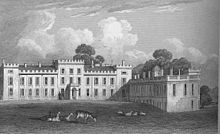
William John Cavendish-Scott-Bentinck, 5th Duke of Portland, styled Lord John Bentinck before 1824 and Marquess of Titchfield between 1824 and 1854, was a British Army officer and peer, most remembered for his eccentric behaviour. A recluse who preferred to live in seclusion, he had an elaborate underground maze excavated under his estate at Welbeck Abbey near Clumber Park in North Nottinghamshire.

Earl of Portland is a title that has been created twice in the Peerage of England, firstly in 1633 and secondly in 1689. What proved to be a long co-held title, Duke of Portland, was created in 1716 and became extinct in 1990 upon the death of the ninth Duke, at which point the earldom passed to the most senior agnatic cousin, namely one of the 6th degree.

William Henry Cavendish-Scott-Bentinck, 4th Duke of Portland,, styled Marquess of Titchfield until 1809, was a British politician who served in various positions in the governments of George Canning and Lord Goderich.

William Arthur Henry Cavendish-Bentinck, 7th Duke of Portland,, styled Marquess of Titchfield until 1943, was a British peer and Conservative politician.
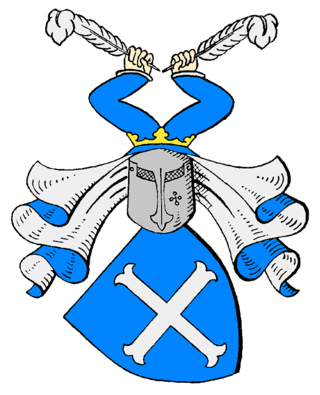
The Bentinck family is a prominent family belonging to Dutch, German and British nobility. Its members have served in the armed forces and as ambassadors and politicians, including as Governor General of India and as Prime Minister of the United Kingdom. The family is related to the British royal family through the maternal Cavendish-Bentinck line of Queen Elizabeth The Queen Mother.

William John Arthur Charles James Cavendish-Bentinck, 6th Duke of Portland,, known as William Cavendish-Bentinck until 1879, was a British landowner, courtier, and Conservative politician. He notably served as Master of the Horse between 1886 and 1892 and again between 1895 and 1905.
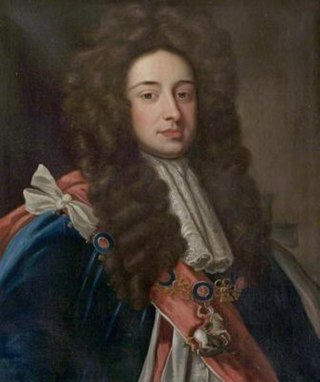
John Holles, 1st Duke of Newcastle, KG, PC was a prominent English peer and politician.

Cavendish-Bentinck is a surname associated with the Dukes of Portland and their descendants. Bentinck is a Dutch surname brought to England by William Bentinck, an advisor to William III of England. Cavendish was added to the family name by Bentinck's great-grandson the 3rd Duke of Portland, who married in 1766 Lady Dorothy Cavendish, daughter of the 4th Duke of Devonshire. By a family arrangement, she was the heiress to estates which had previously belonged to the defunct Newcastle branch of the Cavendish family, including Welbeck Abbey, which became the principal seat of the Dukes of Portland. Following the death of the 9th Duke in 1990, the family name became extinct.

The Cavendishfamily is a British noble family, of Anglo-Norman origins. They rose to their highest prominence as Duke of Devonshire and Duke of Newcastle.

Edward Harley, 2nd Earl of Oxford and Earl Mortimer was an English Tory politician and peer who sat in the House of Commons of Great Britain from 1711 to 1724.

Welbeck is a village and former civil parish, now in the parish of Norton, Cuckney, Holbeck and Welbeck, in the Bassetlaw district, in Nottinghamshire, England. It is slightly to the south-west of Worksop. In 2001 the parish had a population of 31.

Holbeck is a village and former civil parish, now in the parish of Norton, Cuckney, Holbeck and Welbeck, in the Bassetlaw district, in the county of Nottinghamshire, England. It is located 6 miles south-west of Worksop. According to the 2001 census it the parish a population of 449, reducing to 195 at the 2011 Census. It is an estate village built for the Dukes of Portland at Welbeck Abbey.
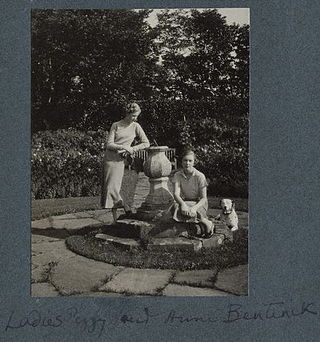
Lady Alexandra Margaret Anne Cavendish-Bentinck was a member of the British nobility and one of the richest landowners in the country. She was a notable charity worker, art collector, and horsewoman.

Ivy Cavendish-Bentinck, Duchess of Portland GBE was Duchess of Portland from 1943 – 1977 and afterwards Dowager Duchess. She initiated the Harley Foundation, "to encourage creativity".
William Speechly was a late 18th- and early 19th-century English horticulturist, best known as the head gardener to William Henry Cavendish-Bentinck, 3rd Duke of Portland, and for his skill in growing pineapples and grapes.

St Winifred's Chapel, Holbeck is a Grade II listed parish church and former private chapel in the Church of England in Holbeck, Nottinghamshire, south-west of Worksop. Holbeck is an estate village built for the Dukes of Portland at Welbeck Abbey.
Henrietta Bentinck, Duchess of Portland, formerly Henrietta Scott, was the wife of William Bentinck, 4th Duke of Portland.

Norton and Cuckney is a former civil parish, now in the parish of Norton, Cuckney, Holbeck and Welbeck, in the Bassetlaw district, within the county of Nottinghamshire, England. The overall area had a population of 351 at the 2011 census. The parish lay in the north west of the county, and south west within the district. The parish lies close to the county border with Derbyshire. It is 125 miles north west of London, 20 miles north of the city of Nottingham, and 5 miles north of the market town of Mansfield. The area was bordering Sherwood Forest and has associations with mining interests and the Welbeck Estate.
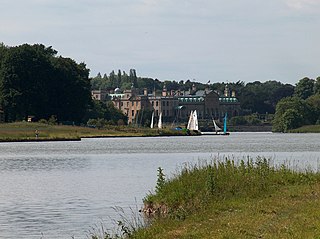
Norton, Cuckney, Holbeck and Welbeck is a civil parish in the Bassetlaw district of Nottinghamshire, England.
Norton and Cuckney was a civil parish in the Bassetlaw District of Nottinghamshire, England. The parish contained 41 listed buildings that are recorded in the National Heritage List for England. Of these, one is listed at Grade I, the highest of the three grades, and the others are at Grade II, the lowest grade. The parish contained the villages of Cuckney and Norton and the surrounding countryside. Most of the listed buildings are houses, cottages and associated structures, and farmhouses. The others include a church, a school, a dam, a public house, eight lodges in the estate of Welbeck Abbey, and a monument.




